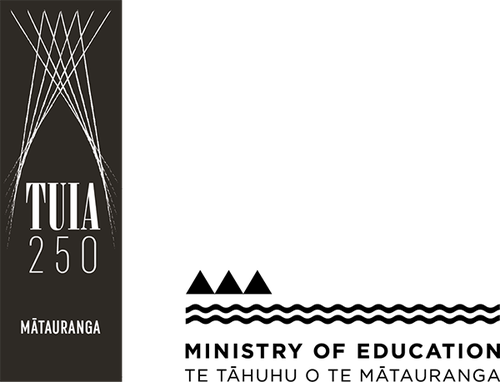I tēnei whārangi On this page
- Introduction
- Royal Visit of the Duke and Dutchess of Cornwall and York to New Zealand
- Mt Eden School
- His Excellency's Visit to Cook Islands and Samoa
- Scenes at the East End Annual Picnic
- Across the Mountain Passes of New Zealand
- New Zealanders for the Front: Official Farewell
- Visit of the Hon WF Massey and Sir J Ward to the Western Front 30 June – 2 July
- He Pito Whakaatu i te Noho a te Māori i te Awa o Whanganui
- Journey into Rua's Stronghold: He Murimuri Aroha ki ngā Mōrehu o Maungapōhatu
- Māori Hui at Tikitiki
- Hapuka Fishing in New Zealand
- The Invincible All Blacks Record Tour
- New Zealand News and Views no. 10, 11, 12
- Valley of Enchantments: Rotorua's Geyser Land
- Nature's Fireless Cooker
- Through Westland's Coalfield
- A Visit North to View the Centennial Celebrations at Waitangi
- Newsreel selection
- New Zealand Diary no.6
- Weekly Review 138, Women Truck Drivers
- Weekly Review 169, NZ Soldiers and Polish Children
- David’s Homecoming
- Weekly Review 232: Māori Battalion Returns
- Love and Sacrifice – a Day in the Service of Christ’s Little Ones
- Pictorial Parade 79: Hutt Valley Youth Club
- Caravan Holiday
- Open day and opening of the Auckland Harbour Bridge
- Waiting for Royal Train, Wellington Floral Decorations
- Ahipara Women's Fire Brigade
- The Golden Shears. International Shearing Competition
- To Live in the City
- The Cook Islands Look Ahead
- Gregg’s Coffee, Different Faces
- Decimal Currency
- Farmers Santa Parade
- Te Matakite o Aotearoa
- Takaparawhā, Bastion Point
- PATU!
- Telethon Highlights
- Billy T James
- 6.30pm News – Rainbow Warrior
- 6.30pm News – Māori Language Kindergarten
- Kupe: Voyaging by the Stars
- 1990 Commission. The Treaty
- Waitangi Day 1990 – Tatou, Tatou, One People
- Marae, Shakti Women’s Hui
- Tagata Pasifika: New Zealand Born Pacific Islanders
- One News – Hikoi
- When a City Falls
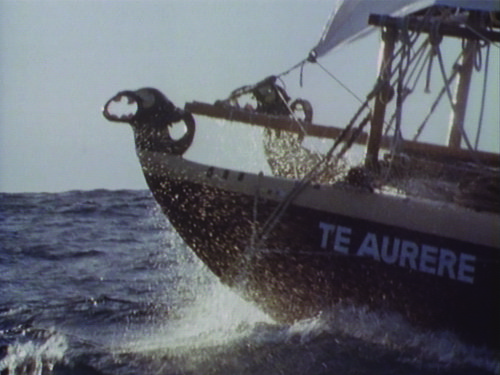
Te Aurere, traditional double-hulled waka belonging to Hekenukumai (Hector) Busby, at sea. Kupe: Voyaging By The Stars. Stills Collection, Ngā Taonga Sound and Vision. Courtesy of Ian John. S292084
Introduction
Ngā wai e rua: Stories of Us is a compilation of excerpts taken from the following films. Many of the films have taken on a new significance as they become a record of people, events and places that have changed beyond recognition.
The reference numbers for each item refer to our online collection where you can find more information about each title.
Royal Visit of the Duke and Dutchess of Cornwall and York to New Zealand
Salvation Army, 1901. Collection reference: F2464 .
The Limelight Department of the Salvation Army (Australia) were commissioned by the New Zealand Government to record the Royal Tour of the colony, which was made to thank New Zealanders for their involvement in the Anglo-Boer War. The royal couple toured the whole country and were filmed in Rotorua and the main centres. Only fragments of the original 3,360 feet (approximately 50 minutes) of film survive.
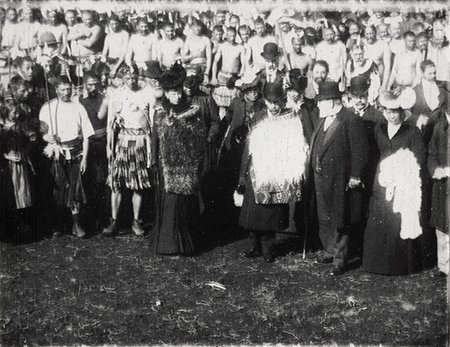
The Duke and Duchess of Cornwall approach the camera escorted by Premier Seddon and Mrs Seddon on either side, Joseph Ward and James Carroll, Minister of Native Affairs. Stills Collection, NTSV. Courtesy of Jim Schuster/Te Arawa. S262265
Mt Eden School
Filmmaker unknown, 1908. Collection reference: F53909 .
Children gather at Mt Eden School in Auckland. It is likely they are celebrating Dominion Day, which became a public holiday for the first time on 26 September 1907. Since 1953 the country has been officially known as the Realm of New Zealand and the 1907 proclamation of dominion status has still not been revoked. This film suffers from nitrate decomposition and despite being a full digital preservation, we will never recover the lost images.
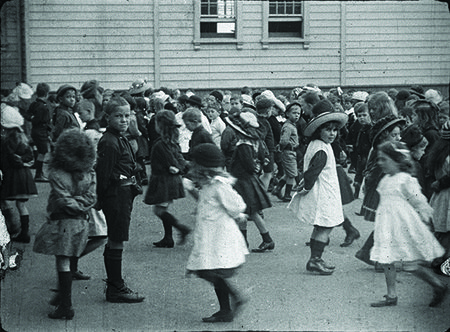
Mount Eden School. Stills Collection, Ngā Taonga Sound & Vision. Courtesy of Lynne McDonald. S292127
His Excellency's Visit to Cook Islands and Samoa
SB Taylor, 1919. Collection reference: F6552 .
The Cook Islands were included within New Zealand’s colonial boundaries in 1901 and achieved self-governance in August 1965. These images are from the official record of the visit by the Governor-General Lord Liverpool and Dr Māui Pōmare, MP for Western Māori and Minister of the Cook Islands, in 1919. The record was filmed for the Department of Agriculture, who at the time were responsible for all government film production.
Scenes at the East End Annual Picnic
New Plymouth, Brandon Haughton, 1912. Collection reference: F2655 .
Commissioned by Garnet Saunders for the Empire Theatre, picnic scenes were screened to an enthusiastic audience within days. Cinema owners recognised the potential of local films to attract an audience eager to catch a glimpse of themselves on film. During the first screening over 800 people squeezed into the Empire, which had capacity of only 630. The Taranaki Herald reported 'the only disappointed ones in the huge crowd were those who could not gain admittance.'
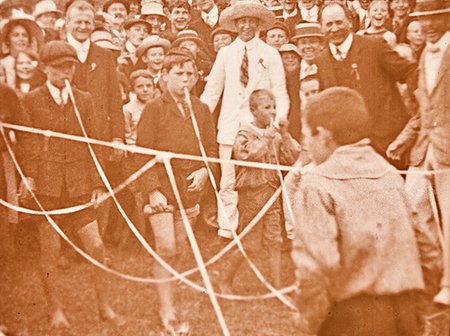
Scenes At The East End Annual Picnic, New Plymouth. Stills Collection, Ngā Taonga Sound & Vision. Courtesy of Phillip Saunders. S262389
Across the Mountain Passes of New Zealand
W Franklyn Barrett, 1910. Collection reference: F10078 .
In 1908 pioneer Australian filmmaker W Franklyn Barrett joined the Melbourne office of the French company Pathé Frères; at the time the world’s largest production company. He took films of scenic interest in Australia and Aotearoa for inclusion in the Pathé Newsreel, which was shown throughout Europe. The colour was created by the early colour process, Pathé color, a costly and elaborate system involving many women cutting stencils for each colour and hand-painting each frame of film. This is New Zealand’s earliest known colour print.
New Zealanders for the Front: Official Farewell
James McDonald, 1914 & 1915. Collection reference: F1820 .
Seeing ‘our boys’ off to war was an important social event and every parade, procession or troopship sailing had a swarm of photographers in attendance. Filmmakers also attended, and the films were quickly in local cinemas. This film is one of the few that survive. Here, in August 1915 the 6th Reinforcement of the New Zealand Expeditionary Force march down Lambton Quay, and the troopship HMNZT No.28 Tofua is loaded at King’s Wharf, later steaming out of the harbour beginning its long journey to Europe and World War One.
Visit of the Hon WF Massey and Sir J Ward to the Western Front 30 June – 2 July
Henry Sanders, 1918. Collection reference: F1068 .
A visit to New Zealand troops on the Western Front, where members of the Pioneer Māori Battalion Te Hokowhitu ā Tu perform a haka for the camera. The New Zealand government made a special arrangement with the Pathé Frères company to film our soldiers in World War One. Equipment at the time was large and unwieldly, and lacking modern mechanics it was impossibly dangerous to film close-up frontline action. The images that survive are mostly of parades, processions and the work of the soldiers and personnel behind the front line.
He Pito Whakaatu i te Noho a te Māori i te Awa o Whanganui
James McDonald, 1921. Collection reference: F2816 .
In the early 20th century, it was widely believed that due to the impacts of colonisation, World War One and the flu epidemic, Māori were a dying race. Between 1921 and 1924, four ethnographic expeditions were undertaken by the Dominion Museum to record traditional Māori life before it passed. In March and April 1921, several weeks were spent on the Whanganui River at Koriniti, Hiruharama and Pipiriki. Expeditions also went to Rotorua, Gisborne and the East Coast.
Journey into Rua's Stronghold: He Murimuri Aroha ki ngā Mōrehu o Maungapōhatu
Edwin Coubray, 1928. Collection reference: F7138 .
In 1928 pioneer film makers Ted (Edwin) Coubray and Edward Brown made the two-day horse trek from Whakatāne to Ruatāhuna and then on to Maungapōhatu in the Urewera ranges to visit the community established by Rua Kēnana. The pair spent a few days as guests of Kēnana filming the community and its activities.
Māori Hui at Tikitiki
NZ Government Publicity Office, 1926. Collection reference: F6678 .
The consecration of St Mary’s Church in Tikitiki on 16 February 1926 was a grand occasion involving the Governor General Sir Charles Ferguson, the Prime Minister Gordon Coates and rangatira from many iwi, including cabinet minister Apirana Ngata. The church, which still stands, was the last major project of Hone Ngātoto, a traditionally-trained carver on the East Coast. The hui was held in late summer when the crops and food necessary for a feast of this size were plentiful and ready for harvest. Kapa haka was performed by Te Arawa, Ngāti Kahungungu and Ngāti Porou.
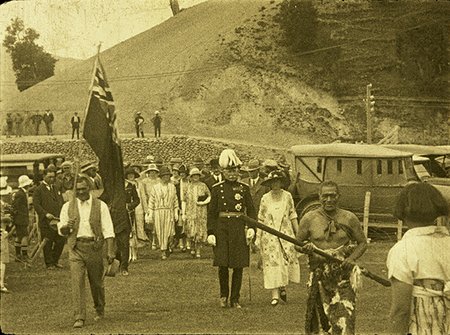
The Governor General, Sir Charles Ferguson and his entourage are welcomed onto Te Rāhui Marae, Tikitiki for the consecration of St Mary’s Church (on February 16th, 1926). Stills Collection, Ngā Taonga Sound & Vision. Courtesy of Ngāti Porou. S292000
Hapuka Fishing in New Zealand
NZ Government Publicity Office, 1925. Collection reference: F6423 .
By the 1920s a small settlement of Italian fishing families was established at Island Bay on Wellington’s south coast. They are an example of chain migration, as most of the families and individuals were from two fishing villages in southern Italy. Here they land the day’s catch of hāpuka and crayfish. Nearly one hundred years later descendants still live in the Wellington area and a section of the south coast has been designated the Taputeranga Marine Reserve.
The Invincible All Blacks Record Tour
Filmmaker unknown, 1924-25. Collection reference: F7026 .
Highlights from the final test played at Twickenham, showing legendary George Nēpia in fine form. Before satellite technology could beam games live into our living rooms, audiences at home had to wait for the highlights to be packaged and express delivered to our side of the globe. From the beginning, the 1924–25 tour to the United Kingdom was a highlight for New Zealand crowds, with 28 games played and won. For the record: New Zealand 658 points for, 98 against.
New Zealand News and Views no. 10, 11, 12
NZ Government Publicity Office, 1928. Collection reference: F4433 .
‘The Construction of the T&G Building’ is one of several items on this edition of the News and Views newsreel. Created before strict health and safety standards were common, the film reflects the Hollywood classic Safety Last , which was made in the same year. Other items covered athletics, prize show cattle, motorcycle racing and Jamuna the baby elephant at Auckland Zoo. As a national newsreel, items came from Whanganui, the West Coast and Auckland, as well as Wellington.
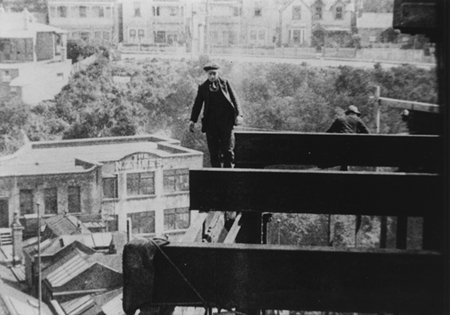
Construction Of The T & G Building (1928). Stills Collection, Ngā Taonga Sound & Vision. Courtesy of the Murtagh/Osborne Collection. S2024
Valley of Enchantments: Rotorua's Geyser Land
NZ Government Publicity Office, 1930. Collection reference: F1025 .
Māori have lived at Whakarewarewa for centuries. This recording shows children diving for pennies from the bridge over the Puarenga River at Whakarewarewa. More recently Tūhorangi Ngāti Wāhiao have shared their daily lives in the model village, giving many Pākehā visitors a glimpse into te ao Māori.
Nature's Fireless Cooker
Fox Movietone News, 1930. Collection reference: F4223 .
Filmed to show the geothermal region, this recording is precious today as one of the earliest to have recorded te reo Māori being spoken. Between 1929 and 1970 Australian company Fox Movietone made 2,300 newsreels for the Australian domestic market, and cameramen travelled far and wide to find interesting news items for inclusion.
Through Westland's Coalfield
W D Frazer, 1930. Collection reference: F11644 .
Miners arrive at Rūnanga Mine high in the hills above Greymouth. Jim Newburn (1900-1985) was from a West Coast mining whānau and for several years he was the projectionist at the picture theatre in Kaitangata. He collected local movies to show in the theatre, and that is possibly how he came to have these images taken at the Runanga Mine by WD Frazer.
A Visit North to View the Centennial Celebrations at Waitangi
Violet Winstone, 1940. Collection reference: F87505 .
A keen amateur filmmaker, Violet Winstone made film records of her family activities and travels from the mid-1930s through to the 1970s. She was one of few women filmmakers at the time and was one of even fewer New Zealanders to have a 16mm colour camera. The centenary of the signing of the Treaty of Waitangi was celebrated at the Treaty Grounds. As well as signing re-enactments and waka launches, the whare runganga was opened and the 28th Māori Battalion marched out at the grounds, beginning their long journey to Europe and World War Two.
Newsreel selection
By the 1940s going to the pictures was our biggest regular entertainment. Along with God Save the King, The Weekly Review screened in cinemas before the main feature. As a Government newsreel, the mix of items showed a homogeneous, happy population at work and play. Included here are some of our favourite items. They aren’t from the same newsreel, but they are typical content. The Weekly Review ran from October 1942 until the series ended with the 459th issue in August 1950.
New Zealand Diary no.6
National Film Unit, 1946. Collection reference: F21959 .
Two newsreel items: ‘Display by Wellington East Girls’ College’, highlighting the benefits of exercise for young women, and ‘Ngāruawāhia Regatta’, showing waka fun on the Waikato River.
Weekly Review 138, Women Truck Drivers
National Film Unit, 1944. Collection reference: F673 .
Women made a huge contribution to the war effort in New Zealand. Items about the war effort at home kept New Zealanders engaged with fundraising and ongoing activities, while items from Europe gave them glimpses of our soldiers and personnel. While we find it uncomfortable, the narration on this item is typical of its time.
Weekly Review 169, NZ Soldiers and Polish Children
National Film Unit, 1944. Collection reference: F685 .
Polish refugees are welcomed to the lower North Island. The Second World War created huge displacement of people in Europe. New Zealand opened its borders and became a destination for many, including 725 children and 113 adult Polish refugees who were welcomed in 1944.
David’s Homecoming
David O’Brien, 1945. Collection reference: F61352 .
This home movie record of the troopship HMS Chitral arriving in Wellington after World War Two echoes the official films made by the National Film Unit. When the war ended in 1945 there were over 58,000 New Zealanders serving overseas, most with the 2nd New Zealand Expeditionary Force in Italy and the Middle East.
Weekly Review 232: Māori Battalion Returns
National Film Unit, 1946. Collection reference: F726 .
The National Film Unit covered the return home of the 28th Māori Battalion on 23 January 1946. After the pōwhiri at Pipitea Wharf the men embarked on trains that would carry them home. The film unit followed the northern train, which was bound for Kaikohe, as far as Ngāruawāhia and Weekly Review 232 concludes at Tūrangawaewae Marae. As in World War One, the Māori contingent was welcomed back as a single unit so Māori could receive the whānau as a whole.
Love and Sacrifice – a Day in the Service of Christ’s Little Ones
AH Reynolds, 1955. Collection reference: F48449 .
Sisters of Compassion at St Vincent’s Home, Auckland, care for young children. Aucklander Alfred Reynolds was a prolific filmmaker; a keen home movie maker, he also operated as a professional. His company AH Reynolds Film Productions kept afloat with commissions from local businesses and groups for short, promotional films.
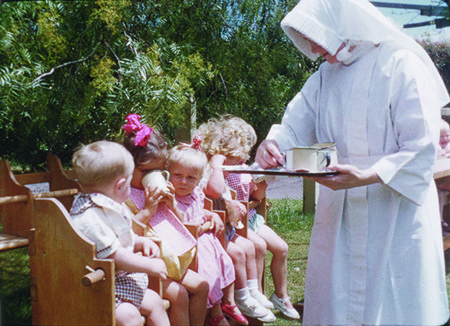
Love And Sacrifice - A Day In The Service Of Christ’s Little Ones. Stills Collection, Ngā Taonga Sound & Vision. Courtesy of the Sisters of Compassion. S292038
Pictorial Parade 79: Hutt Valley Youth Club
National Film Unit, 1958. Collection reference: F3278 .
The rise of the teenager and rock'n'roll in 1950s New Zealand is shown onscreen in this newsreel. The National Film Unit started the Pictorial Parade in 1952, with a new 10-minute newsreel screening in cinemas every month. Like the Weekly Review before it, the Pictorial Parade was made up of topical items promoting a range of New Zealand topics – including teenagers, artists, sports events and unusual houses.
Caravan Holiday
Dr GBA Cowie, 1952. Collection reference: F11300 .
The Cowie whānau annual caravan holiday is reminiscent of many and we are lucky Dr Cowie also recorded family activities with his 16mm camera. The Archive holds a large number of whānau movies, and our collections are rich with images of family events. While they were never intended to be an important historical record, they offer researchers windows into the way we were and home life at different times.
Open day and opening of the Auckland Harbour Bridge
AH Reynolds, 1959. Collection reference: F27453 .
To celebrate opening day, foot traffic was allowed on the bridge for what was believed would be the first and only time. Built over the narrowest stretch of water from St Mary’s Bay to Northcote, and out of the way of the Auckland wharf area, the harbour bridge used 6,500 tonnes of concrete and 6,000 tonnes of steel, and took 200 workers four years to complete. Even before it opened, the four-lane bridge could not meet traffic demands, and in 1969 a further four lanes (two in each direction) were added. They were nicknamed the ‘Nippon Clip-ons’ after the Japanese film that constructed them. Tolls were charged on the bridge until 1984.
Waiting for Royal Train, Wellington Floral Decorations
Philip K. Andrews, 1953. Collection reference: F40020 .
The Royal Tour of HRH Queen Elizabeth II in 1953-54 was a massive civic occasion. Decorations and bunting graced every street, and people, all dressed in their best, staked out the best spots to catch a glimpse of Her Majesty as she travelled past. Everyone with a movie camera seems to have filmed the festivities; the Archive holds a large collection of home and professional films, covering the visit to 46 towns and cities that began in Auckland and ended in Bluff.
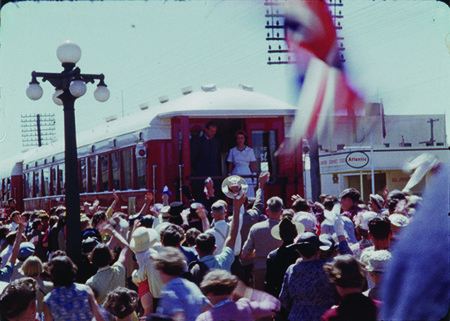
Waiting For The Royal Train. Stills Collection, Ngā Taonga Sound & Vision. Courtesy of Shirley Roderick. S292040
Ahipara Women's Fire Brigade
NZBC, 1965. Collection reference: F101214 .
Firefighters from the Ahipara Women’s Volunteer Brigade show their firefighting skills in this demonstration, which was recorded for the NZBC Town and Around news segment. Working with the community we’ve learned more about these women and their important work.
The Golden Shears. International Shearing Competition
Ian Houston, 1961. Collection reference: F11397 .
Images from the very first Golden Shears competition held in 1961 at the War Memorial Stadium in Masterton. The show surpassed expectations and the crowd was so big that the local Army was called in to help with crowd control. The annual contest is still fiercely competed for today.
To Live in the City
National Film Unit, 1967. Collection reference: TZP19874 .
Māori urban migration increased after World War Two as many people left their home towns in search of work, education and new opportunities. Rural growth had slowed and there were few employment prospects, while growing demand for labour in towns and cities was a draw card. Post World War Two only 26% of the Māori population lived in towns and cities and by 1956 this had increased to 35%. By 1986 nearly 80% of Māori lived in urban areas.
The Cook Islands Look Ahead
National Film Unit, 1965. Collection reference: F55063 .
In 1965 the Cook Islands were preparing for self-government. This film promotes opportunities for Cook Islanders to train in Aotearoa as well as ongoing cooperation between our two countries.
Gregg’s Coffee, Different Faces
Pacific Films, 1970. Collection reference: C1216 .
New Zealand’s first non-animated television commercial featuring a diverse community. Imbued with good feelings the jingle reinforces the message 'different faces, many races living in the sun, good times to remember, we may all live as one.' Directed by Tony Williams for Pacific Films.
Decimal Currency
Morrow Productions, 1966. Collection reference: C1098 .
In 1964 the Government scheduled DC Day (Decimal Currency Changeover) for 10 July 1967. The Zeal and The Kiwi were suggested as names for the new currency, but the word dollar was selected and Mr Dollar became the symbol for the transition. Commercials preparing New Zealanders for the change screened prior to DC Day.
Farmers Santa Parade
AH Reynolds, 1979. Collection reference: F80335 .
Highlights from the Farmers Santa Parade up Queen Street, Auckland. Since 1934 the Parade has celebrated the Festive Season. In 1979 professional filmmaker Alfred Reynolds was out with his Super 8 movie camera catching the sights and sounds.
Te Matakite o Aotearoa
Geoff Steven, 1975. Collection reference: F1502 .
The Māori land march led by Whina Cooper, saw foot traffic on the Auckland Harbour Bridge for the second time. Geoff Steven’s observational political documentary followed the 1975 hīkoi from Te Hāpua Marae in the far north to Parliament in Wellington where the Memorial of Rights petition was presented to Prime Minister, Bill Rowling.
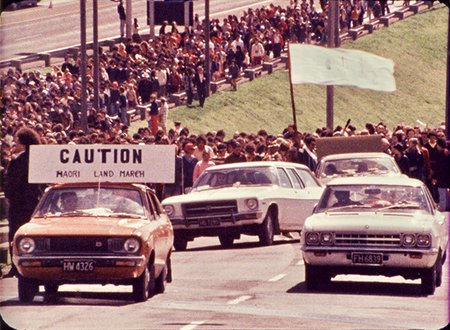
Te Matakite O Aotearoa / The Maori Land March. Stills Collection, Ngā Taonga Sound and Vision. Courtesy of Geoff Steven. S291962
Takaparawhā, Bastion Point
The occupation at Bastion Point was one of the most important events in modern-day Māori protest. Beginning in 1977, when the Muldoon government proposed subdividing the land for residential development, the peaceful occupation ended on the 507th day when Ngāti Whātua ki Ōrākei and their supporters were forcibly removed from their ancestral lands.
News Year 1978
TVNZ, 1978. Collection reference: TZP225018 .
Huge numbers of police and armed services personnel arrive at Takaparawhā, Bastion Point.
Archive News, Bastion Point
TVNZ, 1978. Collection reference: TZP26307 .
Images of the mass arrest of peaceful protestors.
PATU!
Awatea Films, 1983. Collection reference: F3794 .
A major documentary of our time, PATU! details the controversial 1981 Springbok rugby tour to New Zealand, which split the country almost to the point of civil war. In 2012 PATU! was inscribed on the UNESCO Memory of the World, New Zealand Register.
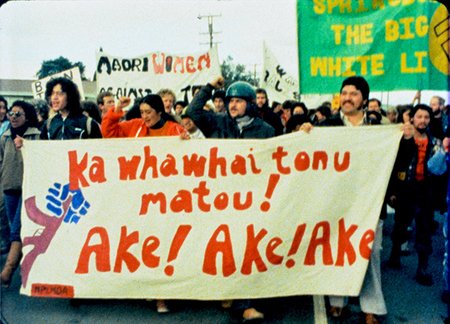
PATU! Stills Collection, Ngā Taonga Sound & Vision. Courtesy of The Estate of Merata Mita. S254878
Telethon Highlights
TVNZ, 1981. Collection reference: TZP411862 .
For many New Zealand children the annual Telethon appeal was an opportunity to participate in crazy fundraising activities, and a chance to stay up all night to watch television. Continual television transmission began in the early 1990s. The much-loved Goodnight Kiwi, which was screened to signal the end of the night’s transmission, was out of a job on TV2 from 24 October 1994.
Billy T James
TVNZ, 1986. Collection reference: TZP75331 .
William James Te Wehi Taitoko MBE (1948-1991) is better known by his stage name: Billy T James. A well-known entertainer, comedian, musician and actor, he was a key figure in the development of comedy here. The Billy T James Show ran for seven series and regularly lampooned contemporary issues, such as New Zealand’s anti-nuclear status. Established in 1997, the Billy T Award recognises an up-and-coming New Zealand comedian each year.
6.30pm News – Rainbow Warrior
TVNZ, 1987. Collection reference: TZP91962 .
The bombing of the Greenpeace ship the Rainbow Warrior in Auckland Harbour in July 1985 shocked the nation and caused outrage when France, a friendly nation, was found to be responsible for the action. Two years after the bombing the Rainbow Warrior was scuttled at Matauri Bay in Northland, where it has become a popular dive site and ongoing reminder of our aspirations to be a nuclear free Pacific.
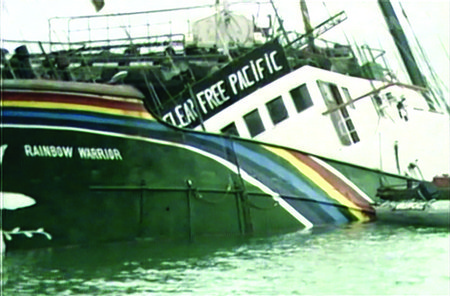
Close Up – Antinuclear. Stills Collection, Ngā Taonga Sound and Vision. Courtesy of TVNZ. S292125
6.30pm News – Māori Language Kindergarten
TVNZ, 1982. Collection reference: TZP40774 .
The first Kōhanga Reo, Pukeatua in Wainuiomata, opened in April 1982. A kaupapa-Māori initiative to revitalise te reo, the movement flourished, and by the end of that year over 100 Kōhanga, Māori language kindergartens, had opened. Today there are more than 460 Kōhanga Reo around the country catering to more than 9,000 mokopuna. Since 1982 Te Kura Kaupapa and Wānanga have been provided for ongoing education ki roto i te reo Māori.
Kupe: Voyaging by the Stars
Peter Turei, 1993. Collection reference: F5371 .
Hekenukumai Pūhipi (Sir Hector Busby) used modern technology to create Te Aurere, a traditional double-hulled ocean-going waka hourua. The master craftsman revived craft and navigational skills practised by tūpuna, ensuring knowledge is retained for future generations.
1990 Commission. The Treaty
Flying Fish, 1990. Collection reference: C2530 .
Directed by Lee Tamahori, this television commercial promotes 150 years of dual heritage and Te Arikinui Dame Te Atairangikaahu reminds us of the possibilities of Te Tiriti – the Treaty of Waitangi.
Waitangi Day 1990 – Tatou, Tatou, One People
TVNZ, 1990. Collection reference: TZP96820 .
The 150th anniversary of the signing of Te Tiriti was a gala occasion at Waitangi with the Aotearoa Māori Arts Festival and 20 newly built waka launched. In a strong and compassionate speech Bishop Whakahuihui Vercoe sways the crowd, turning protesters into supporters of his korero.
Marae, Shakti Women’s Hui
TVNZ, 1997. Collection reference: TZP182629 .
A look at the relationship between Māori and new immigrants. TVNZ’s series Marae has broadcast news and stories of particular interest to Māori since the 1990s. It replaced Koha, the first series devoted to te ao Māori, which began regular broadcast in 1980.
Tagata Pasifika: New Zealand Born Pacific Islanders
TVNZ, 2002. Collection reference: TZP265300 .
New Zealand-born Pacific Islanders describe their ethnicity. The series Tagata Pasifika has broadcast news and stories of particular interest to the Pasifika community since the 1980s.
One News – Hikoi
TVNZ, 2004. Collection reference: TZP287834 .
News footage of the 2004 Seabed and Foreshore hīkoi crossing the Auckland Harbour Bridge. This was the third time the bridge was opened for foot traffic.
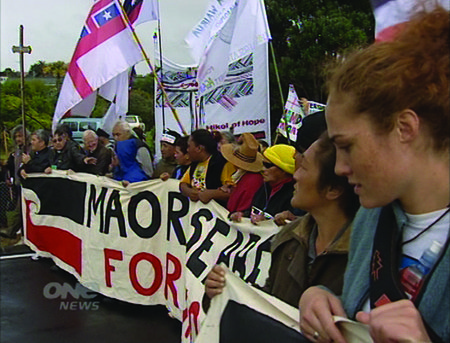
One News - Hikoi. Stills Collection, Ngā Taonga Sound and Vision. Courtesy of TVNZ. S292086
When a City Falls
Frank Film, 2011. Collection reference: F217010 .
Although the 2010 Canterbury earthquakes caused much devastation and tested the resilience of many people, they also drew many New Zealanders together in acts of kindness. Gerard Smyth’s film “travels way beyond earthquake reactive television footage to a tale of hope, an uplifting story that speaks of the kindness of human hearts.”
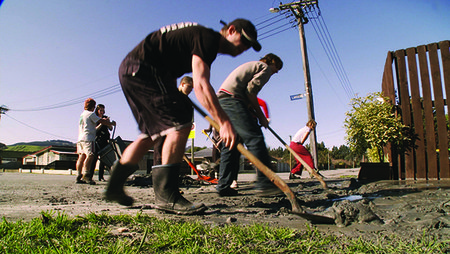
Members of the Student Volunteer Army helping to shovel away liquefaction in Halswell, Christchurch. When A City Falls. Stills Collection, Ngā Taonga Sound and Vision. Courtesy of Frank Film. S292085
